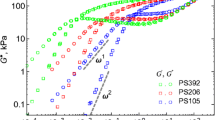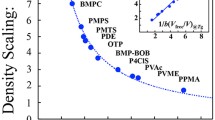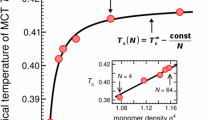Abstract
The discrete slip-link model (DSM) is a robust mesoscopic theory that has great success predicting the rheology of flexible entangled polymer liquids and gels. In the most coarse-grained version of the DSM, we exploit heavily the universality observed in the shape of the relaxation modulus of linear monodisperse melts. For this type of polymer, we present here analytic expressions for the relaxation modulus. The high-frequency dynamics which are typically coarse-grained out from the DSM are added back into these expressions by using a Rouse chain with fixed ends to represent the fast motion of Kuhn steps between entanglements. We find consistency in the friction used for both fast and slow modes. We test these expressions against experimental data for three chemistries and molecular weights with good agreement. Using these analytic expressions, the polymer density, the molecular weight of a Kuhn step, M K, and the low-frequency cross-over between the storage and loss moduli, \(G^{\prime }\) and \(G^{\prime \prime }\), it is now straightforward to estimate model parameter values and obtain predictions over the experimentally accessible frequency range without performing expensive numerical calculations.










Similar content being viewed by others

References
Abramowitz M, Stegun IA (1972) Handbook of mathematical functions, vol 1. Dover New York, p 15
Andreev M, Khaliullin RN, Steenbakkers RJ, Schieber JD (2013) Approximations of the discrete slip-link model and their effect on nonlinear rheology predictions. J Rheol 57:535–557
Andreev M, Feng H, Yang L, Schieber JD (2014) Universality and speedup in equilibrium and nonlinear rheology predictions of the fixed slip-link model. J Rheol 58:723–736
Auhl D, Ramirez J, Likhtman AE, Chambon P, Fernyhough C (2008) Linear and nonlinear shear flow behavior of monodisperse polyisoprene melts with a large range of molecular weights. J Rheol (1978-present) 52:801–835
Bach A, Almdal K, Rasmussen HK, Hassager O (2003) Elongational viscosity of narrow molar mass distribution polystyrene. Macromolecules 36:5174–5179
Baumgaertel M, Schausberger A, Winter H (1990) The relaxation of polymers with linear flexible chains of uniform length. Rheol Acta 29:400–408
Bernabei M, Moreno AJ, Zaccarelli E, Sciortino F, Colmenero J (2011) Chain dynamics in nonentangled polymer melts: a first-principle approach for the role of intramolecular barriers. Soft Matter 71:364–1368
Berry GC, Fox TG (1968) The viscosity of polymers and their concentrated solutions. Springer
Bhattacharjee PK, Oberhauser JP, McKinley GH, Leal LG, Sridhar T (2002) Extensional rheometry of entangled solutions. Macromolecules 35:10131–10148
Carella JM, Graessley WW, Fetters LJ (1984) Effects of chain microstructure on the viscoelastic properties of linear polymer melts: polybutadienes and hydrogenated polybutadienes. Macromolecules 17:2775–2786
Córdoba A, Schieber JD, Indei T (2015) The role of filament length, finite-extensibility and motor force dispersity in stress relaxation and buckling mechanisms in non-sarcomeric active gels. Soft Matter 11:38–57
Doi Masao (1988) The theory of polymer dynamics, vol 73. oxford university press
Doi M, Edwards SF (1978a) Dynamics of concentrated polymer systems. Part 2. Molecular motion under flow. Journal of the Chemical Society, Faraday Transactions 2: Molecular and Chemical Physics 74:1802–1817
Doi M, Edwards SF (1978b) Dynamics of concentrated polymer systems. Part 1. Brownian motion in the equilibrium state. Journal of the Chemical Society, Faraday Transactions 2: Molecular and Chemical Physics 74:1789–1801
Ferry JD (1980) Viscoelastic properties of polymers. Wiley
Fetters LJ, Lohse DJ, Milner ST, Graessley WW (1999) Packing length influence in linear polymer melts on the entanglement, critical, and reptation molecular weights. Macromolecules 32:6847–6851
Gardiner CW (2009) Handbook ofstochastic methods: for the natural and social sciences. Springer
Gestoso P, Nicol E , Doxastakis M , Theodorou DN (2003) Atomistic Monte Carlo simulation of polybutadiene isomers: cis-1, 4-polybutadiene and 1, 2-polybutadiene. Macromolecules 36:6925–6938
Huang Q, Mednova O, Rasmussen HK, Alvarez NJ, Skov AL, Almdal K, Hassager O (2013) Concentrated polymer solutions are different from melts: Role of entanglement molecular weight. Macromolecules 46:5026–5035
Jensen MK, Khaliullin R, Schieber JD (2012) Self-consistent modeling of entangled network strands and linear dangling structures in a single-strand mean-field slip-link model. Rheol Acta 51:21–35
Karatasos K, Adolf DB (2000) Slow modes in local polymer dynamics. J Chem Phys 112:8225–8228
Katzarova M, Andreev M, Sliozberg YR, Mrozek RA, Lenhart JL, Andzelm JW, Schieber JD (2014) Rheological predictions of network systems swollen with entangled solvent. AIChE J 60:1372–1380
Kavassalis TA, Noolandi J (1987) New view of entanglements in dense polymer systems. Phys Rev lett 59:2674
Kavassalis TA, Noolandi J (1988) A new theory of entanglements and dynamics in dense polymer systems. Macromolecules 21:2869–2879
Khaliullin RN, Schieber JD (2009) Self-consistent modeling of constraint release in a single-chain mean-field slip-link model. Macromolecules 42:7504–7517
Khaliullin RN, Schieber JD (2010) Application of the slip-link model to bidisperse systems. Macromolecules 43:6202–6212
Koslover EF, Spakowitz AJ (2014) Multiscale dynamics of semiflexible polymers from a universal coarse-graining procedure. Phys Rev E 90:013304
Kubo R (1966) The fluctuation-dissipation theorem. Rep Prog Phys 29:255
Kubo R (1957) Statistical-mechanical theory of irreversible processes. I. general theory and simple applications to magnetic and conduction problems. J Phys Soc Jpn 12:570–586
Larson RG, Sridhar T, Leal LG, McKinley GH, Likhtman AE, McLeish TCB (2003) Definitions of entanglement spacing and time constants in the tube model. J Rheol (1978-present) 47:809–818
Likhtman AE (2005) Single-chain slip-link model of entangled polymers: simultaneous description of neutron spin-echo, rheology, and diffusion. Macromolecules 38:6128–6139
Likhtman AE, McLeish TC (2002) Quantitative theory for linear dynamics of linear entangled polymers. Macromolecules 35:6332–6343
Liu C, He J, van Ruymbeke E, Keunings R, Bailly C (2006) Evaluation of different methods for the determination of the plateau modulus and the entanglement molecular weight. Polymer 47:4461–4479
Marciano Y, Brochard-Wyart F (1995) Normal modes of stretched polymer chains. Macromolecules 28:985–990
Mark JE (1999) Polymer data handbook. Oxford University, England, pp 804–805
Pilyugina E, Andreev M, Schieber JD (2012) Dielectric relaxation as an independent examination of relaxation mechanisms in entangled polymers using the discrete slip-link model. Macromolecules 45:5728–5743
Qiu X, Ediger MD (2000) Local and global dynamics of unentangled polyethylene melts by 13c nmr. Macromolecules 33:490–498
Quake SR, Babcock H, Chu S (1997) The dynamics of partially extended single molecules of dna. Nature 388:151–154
Roland C (2006) Mechanical behavior of rubber at high strain rates. Rubber Chem Technol 79:429–459
Rouse PE (1953) A theory of the linear viscoelastic properties of dilute solutions of coiling polymers. J Chem Phys 21:1272–1280
Rubinstein M, Colby RH (2003) Polymer physics. Oxford University Press
van Ruymbeke E, Coppola S, Balacca L, Righi S, Vlassopoulos D (2010) Decoding the viscoelastic response of polydisperse star/linear polymer blends. J Rheol (1978-present) 54:507–538
Saphiannikova M, Toshchevikov V , Gazuz I , Petry F , Westermann S , Heinrich G (2014) Multiscale approach to dynamic-mechanical analysis of unfilled rubbers. Macromolecules 47(14):4813– 4823
Schausberger A, Schindlauer G , Janeschitz-Kriegl H (1985) Linear elastico-viscous properties of molten standard polystyrenes. Rheol Acta 24:220–227
Schieber JD (2003) Fluctuations in entanglements of polymer liquids. J Chem Phys 118:5162–5166
Schieber JD, Neergaard J, Gupta S (2002) A full-chain, temporary network model with sliplinks, chain-length fluctuations, chain connectivity and chain stretching. J Rheol 47:213–233
Schieber JD, Andreev M (2014) Entangled polymer dynamics in equilibrium and flow modeled through slip links. Ann Rev Chem Biomol Eng
Schieber JD, Indei T, Steenbakkers RJ (2013) Fluctuating entanglements in single-chain mean-field models. Polymers 5:643–678
Steenbakkers RJ, Schieber JD (2012) Derivation of free energy expressions for tube models from coarse-grained slip-link models. J Chem Phys 137:034901
Steenbakkers RJ, Tzoumanekas C, Li Y, Liu WK, Kröger M, Schieber JD (2014) Primitive-path statistics of entangled polymers: mapping multi-chain simulations onto single-chain mean-field models. New J Phys 16:015027
Van Kampen NG (1992) Stochastic processes in physics and chemistry, vol 1. Elsevier
Vandoolaeghe WL, Terentjev EM (2007) A Rouse-tube model of dynamic rubber viscoelasticity. J Phys A: Math Theor 40:14725
Wang S, Wang S-Q, Halasa A, Hsu W-L (2003) Relaxation dynamics in mixtures of long and short chains: tube dilation and impeded curvilinear diffusion. Macromolecules 36:5355–5371
Whitley DM, Adolf DB (2012) Local segmental dynamics of cis-1, 4-polybutadiene, polypropylene and polyethylene terephthalate via molecular dynamics simulations. Mol Simul 38:119–123
Author information
Authors and Affiliations
Corresponding author
Electronic supplementary material
Below is the link to the electronic supplementary material.
Appendices
Appendix 1: Derivation of rouse modes
We assume that the SD and CD processes are much slower than the motion of individual Kuhn steps so that we can treat the entanglements as effective cross-links for each strand of the chain. Thus, we have a Rouse strand (Rouse 1953) with fixed ends. In the continuous limit, the Langevin equation for r s is given by
where r s is the position in space of a bead at position s (0≤s≤l) along the strand contour, \(\tau _{\mathrm {K}}=\frac {\zeta _{\mathrm {K}}a_{\mathrm {K}}^{2}}{k_{\mathrm {B}}T}\), and f s (t) is the fluctuating force representing the interactions of the beads with the mean field. According to the fluctuation dissipation theorem (FDT) (Kubo 1966; Van Kampen 1992), the moments of the random forces are given by
The boundary conditions for the network strand are
These boundary conditions are satisfied by the normal mode solution
in terms of the normal mode coordinates x p defined by
We multiply each side of Eq. A1 by \(\sin \left (\frac {s\pi m}{l}\right )\) and integrate s from 0 to l to find
where \(\lambda _{m}:=\left (\frac {l}{\pi m}\right )^{2}\tau _{\mathrm {K}}\) and \({\hat {\boldsymbol f}_{m}}:=\frac {2\pi }{l} {{\int }_{0}^{l}}{\boldsymbol f}_{s}(t)\sin \left (\frac {s\pi m}{l}\right )\mathrm {d}s\).
Using the FDT (Eq. A2), the Langevin equation can be written as the stochastic differential equation
This is an Ornstein-Uhlenbeck process where dW m(t) is a Wiener increment. Equation A8 can be solved using Itô calculus with solution (Gardiner 2009)
and cross-correlation functions given by
We need the second moment which can be found from the free energy of a strand given in Eq. 8. Using the same procedure as before, we can write the free energy in normal modes
From here, we can see that the second and first moments for a Gaussian distributed function are given by
where δ is the identity tensor and δ pq is the Kronecker delta function. The stress in a strand is calculated according to Eq. 9
The relaxation of a strand can be calculated from the Green-Kubo expression resulting in Eq. 10. For the entire chain, the relaxation modulus is given by
By definition of the conditional probability,
for chains where Z is large. Using these results in Eq. A16, we obtain the final expressions shown in “High-frequency dynamics.”
Appendix 2: Analysis of relaxation modulus predictions
The relaxation modulus, G(t), can be represented using a continuous spectrum of relaxation times, h(τ),
as suggested by Baumgaertel et al. (1990) (BSW). This function allows us to convert the G(t) of a DSM prediction from the time to the frequency domain. Here, we use a modified BSW spectrum with m modes, which has the form
where H(x) is the Heaviside step function. The complex modulus, G ∗, is calculated from the one-sided Fourier transform of the relaxation modulus multiplied by i ω, with {α i ,τ i } as fitting parameters (Khaliullin and Schieber 2009)
where the storage modulus, \(G^{\prime }\), is given by
and the loss modulus, \(G^{\prime \prime }\), is given by
where 2 F 1(a,b;c;z) is the hypergeometric function (Abramowitz et al. 1972).
Rights and permissions
About this article
Cite this article
Katzarova, M., Yang, L., Andreev, M. et al. Analytic slip-link expressions for universal dynamic modulus predictions of linear monodisperse polymer melts. Rheol Acta 54, 169–183 (2015). https://doi.org/10.1007/s00397-015-0836-0
Received:
Revised:
Accepted:
Published:
Issue Date:
DOI: https://doi.org/10.1007/s00397-015-0836-0



